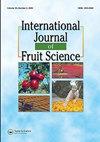利用主动间接模式太阳能干燥机蒸煮香蕉的近义词和微生物组成
IF 2.5
3区 农林科学
Q2 HORTICULTURE
引用次数: 0
摘要
摘要采用主动间接日光干燥法,测定了香蕉蒸煮后的近似组成和微生物组成。该研究旨在比较干煮香蕉与类似产品如香蕉和大蕉的质量。该产品的新鲜样本是从尼日利亚乌穆代克的一个当地市场获得的。样品清洗,剥皮,切片至所需厚度(4至20毫米),然后装入干燥机。干燥后测定粗蛋白质、粗脂肪、碳水化合物含量、灰分含量和水分含量。同时测定了干燥样品的微生物负荷。其水分含量为10.20%,粗蛋白质含量为7.18%,粗脂肪含量为3.61%,碳水化合物含量为85.61%,分别高于未熟香蕉的6.00%、3.06、2.80和82.90%。其灰分含量(2.21%)低于未熟香蕉(2.95%)。从样品中共分离到38株细菌,其中鉴定为葡萄球菌、亚芽孢杆菌和微球菌。从干燥样品中分离到11株霉菌(真菌),以曲霉和Absidia sp为主。观察到真菌的发生频率高于细菌的分离。本文章由计算机程序翻译,如有差异,请以英文原文为准。
Proximate and Microbial Composition of Cooking Banana Dried Using an Active Indirect Mode Solar Dryer
ABSTRACT The proximate and microbial composition of cooking banana was determined after an active indirect solar drying experiment. The study was aimed at comparing the quality of dried cooking banana with similar products like banana and plantain. Fresh samples of the product were obtained from a local market in Umudike, Nigeria. The samples were washed, peeled, and sliced to the desired thickness (4 to 20 mm), before being loaded onto the dryer. The crude protein, crude lipid, carbohydrate content, ash content, and moisture content were determined after the drying experiment. The microbial load of the dried samples was also determined. The moisture content (10.20%), crude protein (7.18%), crude lipid (3.61%), and carbohydrate (85.61%) were higher than 6.00, 3.06, 2.80, and 82.90% respectively obtained for unripe banana. The ash content (2.21%) was lower than that of unripe banana (2.95%). A total of thirty-eight (38) bacterial isolates were observed from the sample and some of which were identified as Staphylococcus sp, bacillus subillus, and micrococcus sp. Eleven (11) molds (Fungal) were isolated from the dried samples, with Asperligillusniger and Absidia sp dominant. The frequency of occurrence was observed to had been higher in fungal than bacterial isolates.
求助全文
通过发布文献求助,成功后即可免费获取论文全文。
去求助
来源期刊

International Journal of Fruit Science
Agricultural and Biological Sciences-Agronomy and Crop Science
CiteScore
6.40
自引率
0.00%
发文量
64
审稿时长
10 weeks
期刊介绍:
The International Journal of Fruit Science disseminates results of current research that are immediately applicable to the grower, extension agent, and educator in a useful, legitimate, and scientific format. The focus of the journal is on new technologies and innovative approaches to the management and marketing of all types of fruits. It provides practical and fundamental information necessary for the superior growth and quality of fruit crops.
This journal examines fruit growing from a wide range of aspects, including:
-genetics and breeding
-pruning and training
-entomology, plant pathology, and weed science
-physiology and cultural practices
-marketing and economics
-fruit production, harvesting, and postharvest
 求助内容:
求助内容: 应助结果提醒方式:
应助结果提醒方式:


